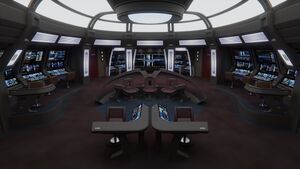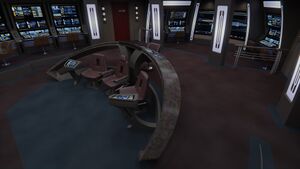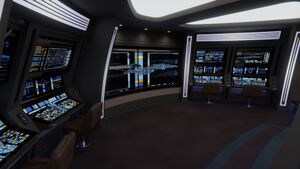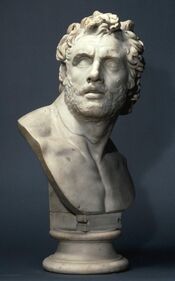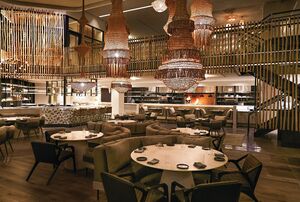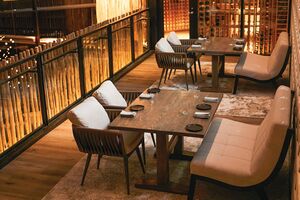Difference between revisions of "USS Ulysses (NCC-78242)"
(Rollback as this should have been moved instead and will be shortly) Tag: Manual revert |
m (McGig moved page USS Ulysses to USS Ulysses ( NCC-78242) without leaving a redirect: Moving as ship is retired to make way for new hotness) |
(No difference)
| |
Revision as of 23:23, 1 June 2024
- "Much have I suffered, labored long and hard by now in the waves and wars. Add this to the total—bring the trial on!"
- —Ulysses, in The Odyssey - Ship's Dedication Quote
A symbol of elegance from an age of peaceful exploration and scientific endeavour, a presence never to be scoffed at or underestimated, Ulysses is a vessel of legend. Like her Galaxy-class brethren, Ulysses has been involved in first, second and third contact missions with hundreds, if not thousands of species since her commissioning in the 2360's. Whilst age now limits her kind to less than forty travelling the stars, her space frame no longer under construction and the final of her scheduled major refits having concluded, Ulysses, like the rest of her class, remains a posting of prestige.
Named after the hero of The Odyssey, written by the Greek poet Homer in the 8th century BC, and a key figure in Greek mythology, Ulysses of Ithaca was famous for having had the idea, during the Trojan War, to hide inside a giant wooden horse with his army to attack the Trojans by surprise. The rest, of course, is legend. But his name, his story and his fate heavily influence the design and naming structures in place aboard the Ulysses today.
USS Ulysses is currently assigned to the Fourth Fleet.
Key Historical Data
2377-2389: The Ison Bale Years
One of the last Galaxy-class starships to be constructed, Starfleet had hoped that the the Ulysses would be complete in time to play a part in the Dominion War, but with the construction teams unable to complete the installation of many key systems in time, she was forced to sit on the sidelines whilst the conflict played out. She was eventually launched to much fanfare in 2377 under the command of Captain Ison Bale.
Finally in command of a much-vaunted explorer, Bale was charged with leading the Ulysses crew on a ten-year odyssey deep into the Alpha Quadrant, a mission of peaceful exploration which reiterated the Federation's commitment to their core mandate. During her voyage, Ulysses was able to demonstrate the full potential for independent, unsupported exploratory endeavors that ships of her lineage were capable of at long last.
Participating in several dozen first-contact missions beyond the borders of Federation space, Ulysses was often considered a choice assignment under Bale's command. When the supernova disaster loomed over the Romulan Star Empire in the 2380's, many vessels found themselves recalled to participate in Admiral Picard's rescue armada, or to patrol borders and prepare for the worst, but not Ulysses. Instead, Captain Bale and the crew of the Ulysses were permitted to continue with their highly important mission, even more critically after the destruction of Mars in 2385 when many in Starfleet urged for a more inward-looking focus. It was only upon the natural conclusion of their teny year mission that Ulysses finally returned to a much changed Federation space.
It was this change in focus for Starfleet that saw an end to Captain Bale's command of the Ulysses. Upon returning from some much-needed shoreleave, Bale learned that his ship would not be returning to deep space, but would instead be serving as the focal point of the Fifth Fleet's defensive mission along the Romulan border. This was not a mission he felt suited his talents, or that of his crew, and he opted to move on from command of the Ulysses, leaving the crew in limbo for a short time.
2389-2400: The Decade In Between
During a decade where Starfleet's focus was drawn away from her original mandate of peaceful exploration and scientific discovery, the Ulysses crew did their best to stick to the old ways. Even with three commanding officers and a variety of missions pulling the ship away from their mandate and the first contact missions of old, the crew were still able to participate in dozens of second and third contact missions of significant priority. Despite undergoing a final round of refits in the early 2390's to ensure she remained one of Starfleet's premier all-round explorers, the crew knew that Ulysses's time was numbered. She would soon be supplanted in the key areas of diplomatic, tactical, and scientific abilities by the Odyssey, Sovereign, and Century-class ships respectively. But that was for then, this was for now. Making the most of upgrades to her bioneural computer systems, ship-wide holographic projectors, and enhanced tactical systems, Ulysses was eventually requisitioned by Sebastian Farrell at the turn of the century for a special mission.
Early 2400: Fallen Empire
In the aftermath of a catastrophic coup on the new Romulan homeworld of Rator, large swathes of Romulan territories declared their independence from the empire, surging forth on a path to self-sufficiency and self-determination. Starfleet dispatched the Fourth Fleet to the Romulan border with invitations to support the people of these worlds in their quest for freedom from oppression. One such world, Kunhri III, had been a heavily industrialised world, long reliant on food shipments from beyond the sector to feed its large workforce populace. On the eve of the Star Navy coup, Romulan overseers had stripped the planet’s refineries of key technologies that caused all infrastructure to shut down. With no alternative, the planet's rulers called for Federation assistance.
In response to the call for aid, Starfleet dispatched a small task group to the Kunhri system. On the face of it, the task group was a kitbash of random vessels, but each had been specifically chosen with a purpose to fulfil. The Anthropology team aboard the Springfield-class USS Dvorak had been dispatched to assist the people of Kunhri III with food security in the absence of food distribution from the Star Empire, while the Inquiry-class ‘pocket battleship’ known as the USS Temeraire provided the muscle for the task group, serving as the strategic operations command center for the expedition. Joining the party a little later, Ulysses arrived at Kunhri with Farrell looking for someone in particular. He found that someone aboard the Temeraire.
Reuniting with his longtime friend and former executive officer aboard the USS Santa Fe, Captain Tharia sh'Elas, Farrell made it clear that he needed people that he could trust for a sensitive mission. The government on Kunhri had been scheduled to receive a shipment of supplies from their friends at Psi Velorum, but the convoy had been halted in the Opra system, with forces loyal to the Romulan Navy preventing the convoy from going anywhere. Seconded to the ship for the duration of the mission, Captain sh'Elas and her crew from the Temeraire made the Ulysses their home throughout the negotiations for the supplies, and the subsequent convoy trip through the dangerous Velorum nebula.
Upon the successful completion of their mission, Captain and crew were prepared to return to the Temeraire when they were presented with an alternative; remain as the new, permanent command crew of the Ulysses. For sh'Elas it was not even a choice. A child of the 'Galaxy lineage', having spent some nineteen years aboard different vessels of the family group, the Andorian jumped at the chance to command such a prestigious posting as Ulysses. Like the Captain, her crew (somewhat surprisingly) rejected the chance to return to the far newer Temeraire in order to stay aboard the far more luxurious, far more prestigious vessel. With her new command crew in place, the ship returned to Federation space upon the completion of her mission and spent the next few weeks above Trill, until a development would occur, one that would shake the crew to their core.
Mid 2400: Exploration is the Key
Initially re-assigned to Task Force 72 of the Fourth Fleet, the Ulysses was ordered to return to Romulan space as part of the group's diplomatic initiative, tasked with conducting first contact missions throughout the independent regions. But a personal matter for a member of the crew saw Captain sh'Elas ignore her orders and take the Ulysses on the hunt for a missing fugitive. Their search took the ship to the Kabrel system where, after many hours of searching, debris matching the description of the vessel they were hunting was located on the third planet. Upon beaming the debris to the ship and investigating it further, investigations concluded that the vessel had been destroyed by a Miradorn Raider, but there were no signs of any fatalities.
Reporting her findings to Command, sh'Elas was suitably chastised by Commodore Uzoma Ekwueme and threatened with removal from command should she ever ignore her orders again. As a result, Ulysses was transferred to Task Force 17's explorative initiative and the ship was recalled to Guardian Station for a major new operation...
Commanding Officers
In the time since her construction, Ulysses has had two long-term commanding officers (including newly appointed Captain sh'Elas), and three short-term commanding officers.
- 2377-2389: Captain Ison Bale, (Human Male)
- 2389-2391: Captain Nilani Azulas, (Trill Female)
- 2392-2395: Captain Kables Skirsh, (Tellarite Male)
- 2395-2400: Captain Virgor, (Benzite Male)
- 2400-2400: Commodore Sebastian Farrell, (Human Male)
- 2400-2400: Captain Tharia sh'Elas, (Andorian Female)
Key Location Data
With over 40 decks, the ship has hundreds of rooms and locations that serve a variety of purposes for the crew. Some of the more notable locations include:
Bridge, Deck 1
Consisting of an amalgamation of successful features from both the Galaxy and Sovereign lineages, and also one major new addition, the Ulysses has one of the more unique bridge modules in the fleet. Importantly, it makes the most of a variety of technological advancements, such as holoprojectors, holographic communications, in-built weapons lockers and three-dimensional computer displays wherever possible.
In a move away from more recent styles, and harking back to the traditional layouts of yesteryear, the Ulysses has an ornately carved rail, known as The Arch, surrounding the command pit and housing a large tactical display used by members of the Tactical Operations Department for all offensive and defensive operations. In the command pit it surrounds, three chairs stand ready for the Captain, her Executive Officer (starboard) and a third seat (port), reserved for the use of the ship's Counsellor, Chief Medical Officer or any official or dignitary the Captain sees fit. Both chairs flanking the Captain have their own stand-alone consoles to enable the occupying officers to conduct their duties, whilst the command chair itself has control built into the arms on either side, allowing the Captain unprecedented control from the seat of command (although sh'Elas is much more of a traditionalist and will delegate tasks to others where possible).
Directly ahead of the command pit, at the bottom of the ramp and between the commanding officer and the holographic viewscreen, two angled consoles serve as duty stations for Operations (port) and Flight Operations (starboard). Next, and facing the main focal point of the viewscreen, are duty stations for science (port) and engineering (starboard). Around the outside of the bridge, there are countless other additional stations. Behind the main science station on the port bulkhead, additional science and medical consoles are available for mission operations, as well as access to life support. Adjacent to them on the starboard bulkhead, engineering is the focus with additional controls allowing the Chief Engineer access to the same engineering systems as in engineering itself, including access to environmental controls, propulsion systems and the warp core.
Most notably, and an exciting feature for inclusion, the bridge has been set back a short distance to allow for an additional facility. Separated from the rest of the bridge by two steps and a railing, the new Strategic Operations suite (known colloquially as StratOps) allows the crew to deal with any scenario that may arise in their mission, without the need to access more specialised facilities around the ship unless absolutely necessary or appropriate. Operations are routinely monitored here, and additional personnel from across the ship may be assigned on a needs basis, such as additional medical or science personnel when evacuating a colony or dealing with an anomaly; security may be beefed up from here in the event of a tactical scenario such as an intruder alert or boarding action; intelligence, strategic operations and command analysts are likely to use the space to provide relevant departments with up to date information in ever-changing scenarios. On the back wall, the obligatory Master Systems Display (MSD) is present, but this is a fully customisable display, capable of hundreds of functions, including operating as a reduced viewscreen for mission operations. Most significantly, the space allows for the crew to react to an evolving situation without the need to retreat to the observation lounge.
Around the command center, six doors provide access to and from the bridge. On the forward port bulkhead, access is available to the observation lounge and Executive Officer's ready room, whilst the starboard door grants access to the commanding officer's private ready room (available for use by any officer in command of the ship), and a forward turbo lift granting express access to key locations only, such as engineering, shuttlebay 1, sickbay, the brig and transporter rooms 1 and 2. At the aft of the bridge, both doors provide access to turbo lifts which enable the crew to access the command center from the rest of the bridge.
The Bust of Ulysses
Standing on a plinth on the starboard wall, between the Captain's ready room and the express turbo lift, and beneath the Ulysses dedication plaque, an ornate bust of the ancient Greek hero Ulysses, a legendary Greek king of Ithaca, serves as a source of inspiration and omen for many on the crew. A reminder of perseverance and resilience thanks to his decade-long journey to Greece, the statue reminds all aboard that anything is possible if you don't give up or give in. But the statue also reminds people of how valiant, mighty and intelligent Ulysses was, following his crucial intervention in the Trojan War.
Originally located in main engineering, the statue was moved to the bridge and given a new focal point by Captain sh'Elas upon her acceptance of command.
Depending on who you talk to, the statue is a source of inspiration, of strength. But should the statue ever fall, should it be damaged, or gods forbid be broken, it is believed that a terrible fate will befall the crew of the Ulysses.
The Acropolis, Deck 10
Named after the Acropolis of Athens, an ancient citadel that once sat upon a rocky outcrop high above the city of Athens, Greece, the Acropolis is the largest of several mess facilities aboard the Ulysses. With its monuments serving as universal symbols of the classical spirit and the greatest architectural and artistic works of Ancient Greece, the Acropolis was home to some of the most recognisable and historic monuments ever found on Earth.
Spread across two floors, the once sterile and basic Starfleet lounge has been remodelled to incorporate a mixture of classical and 21st-century modern Greek design. Despite the remodel, the Acropolis remains an important, functional space aboard the ship; a place for leisure pursuits of the crew or the formal hosting of dignitaries welcomed aboard the ship. On the main level, the focal point is a beautiful replica of a wood-burning hearth, adjacent to a 62-seat lounge and an open kitchen, and, along the aft wall, a 10-seat bar stocked with the finest real liqueurs and synthahols available. On the upper level, a private, spartan lounge for more intimate discussions is available to all, civilian or Starfleet alike.
The Acropolis is run and maintained around the clock by over twenty-five different people, ensuring that the people aboard the Ulysses are free to enjoy fine dining, fine company and fine art whatever the time of day.
